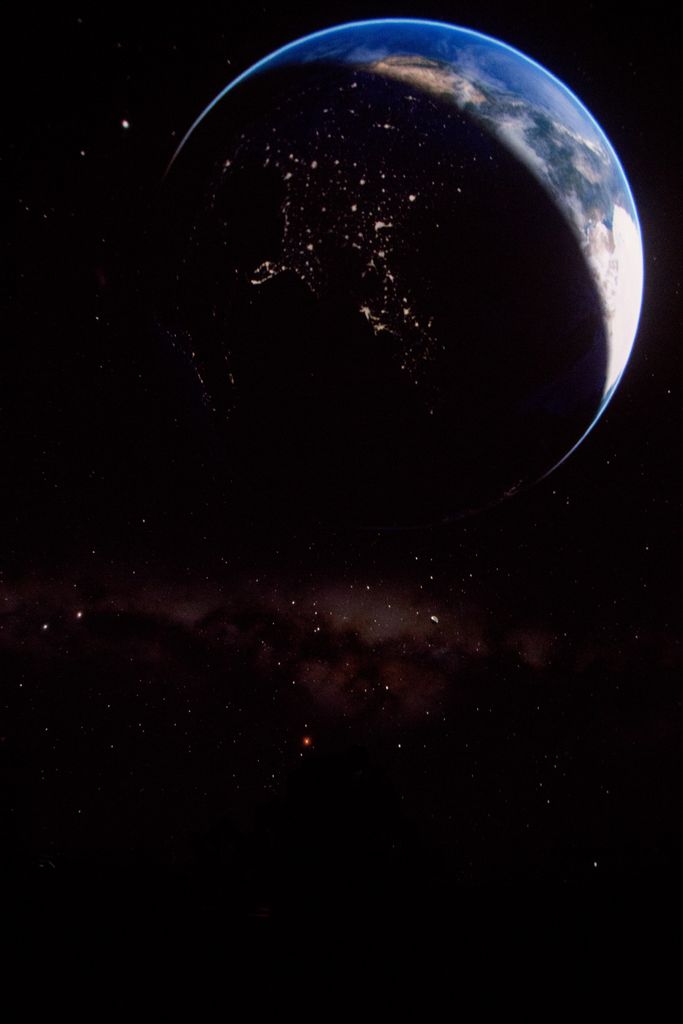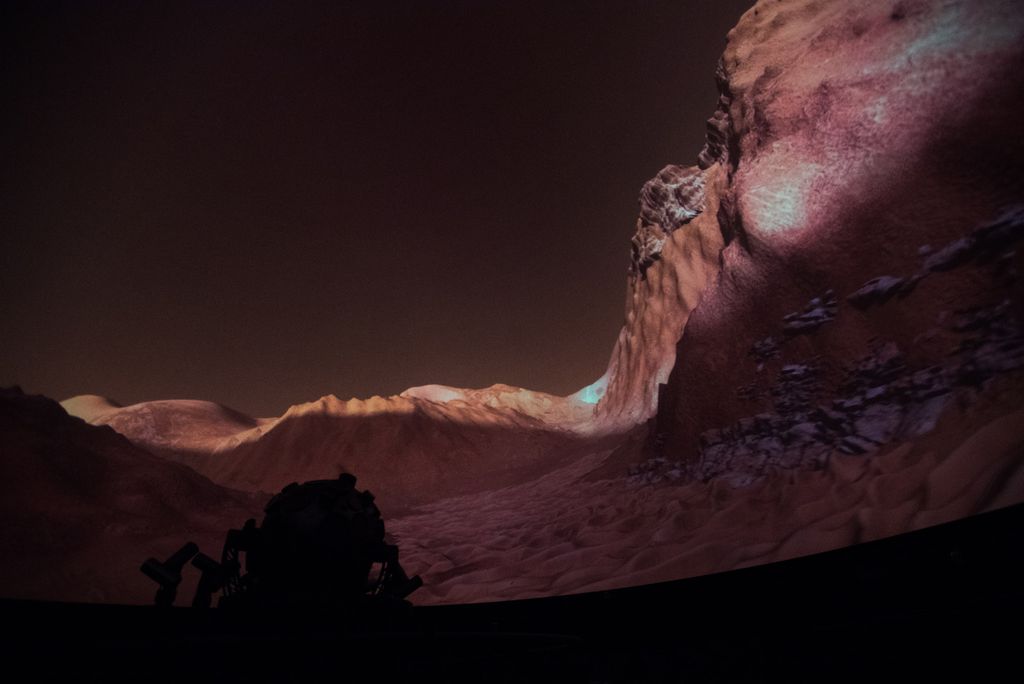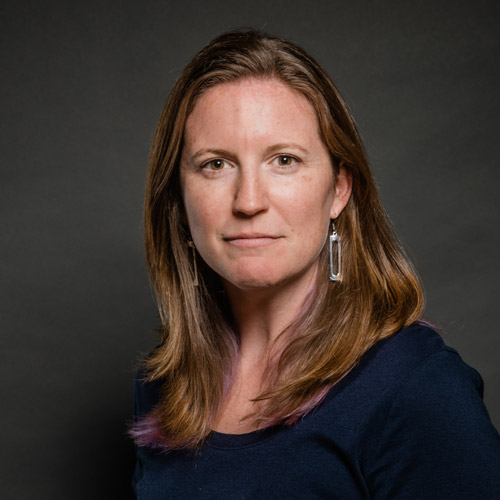Does Stargazing Alum Dani LeBlanc Have the Coolest Job in Boston?
Dani LeBlanc (CAS’01) has been working at the Museum of Science Charles Hayden Planetarium for 19 years. In the video above, she takes us on a trip inside the planetarium.
Does Stargazing Alum Dani LeBlanc Have the Coolest Job in Boston?
As planetarium director at Boston’s Museum of Science, she’s in charge of transporting viewers into outer space
A little after four on a Wednesday afternoon, I sat in the middle of Boston with Dani LeBlanc (CAS’01) looking up at a sky full of stars.
Okay, so we were actually in the Charles Hayden Planetarium at the Museum of Science, where LeBlanc has what must be one of the coolest jobs in the city—planetarium director. She was “piloting”—controlling the simulated universe above us from behind a console at the edge of the planetarium—and was demonstrating to me the planetarium’s impressive database of astronomically accurate simulations, but it was taking a little while to pull up the specific celestial object she was looking for.
“I have to load the universe,” she explained.
This software is used for the Hayden Planetarium’s Explore: The Universe space show, an interactive tour through an animated version of outer space that the museum offers once a day. It is made with the same technology used by video game developers, so the pilot can navigate through space similar to the way gamers traipse through post-apocalyptic Boston in Fallout 4.
During each space show, one member of the planetarium team pilots while another is the live presenter. Together, they guide the audience through the solar system, the Milky Way, and beyond. As they fly, audience members can ask the presenter questions and even direct the journey.
For my private viewing, LeBlanc asked me my favorite planet. I said Saturn, and suddenly we were leaving the surface of the Earth and zooming through the solar system. Once the sixth planet was hovering in the “sky” above us, ringed and glowing in its golden glory, LeBlanc hit another button on her computer. Suddenly, Saturn’s dozens of moons were called out in glowing white circles. They orbited Saturn slowly, tracing bright green lines to show their paths.
“If astronomers were to discover another moon around Saturn, we have the ability to dive into the system and program it so that you can actually bring up that orbit line,” says LeBlanc.
The development of shows is something I really love to do. I love creating something out of nothing.
LeBlanc knows a thing or two about orbital mechanics: she majored in astronomy and physics at BU.
Her interest in outer space began when she was young. LeBlanc remembers her father showing her the Big Dipper when she was about eight years old. A native of Yorktown, a city less than 40 miles north of Manhattan, she would visit the planetarium at the Museum of Natural History in New York City when she was growing up. She went to Boston’s Museum of Science on a field trip in seventh grade and remembers seeing the Laser Floyd show in the Hayden Planetarium.
But when she started taking astronomy courses at BU, LeBlanc became disenchanted. She found that she cared more about the fascinating and mind-blowing concepts and less about the math and physics behind them.
So it was serendipitous that LeBlanc decided to tag along with her Kappa Kappa Psi fraternity brothers to the Museum of Science during 2000 Senior Week. She stumbled upon the planetarium, thought it was cool, and applied for its internship program. She got the job, and that summer started work as the planetarium presenter intern.
Now, 19 years later, she still hasn’t left.

Starting out, LeBlanc had a lot to learn about producing planetarium shows. “There’s no planetarium degree at school, so it’s all on-the-job training,” she says. The members of the eight-person planetarium team hold diverse sets of skills, from writing and editing to music, art, and visuals. They all work together to make visually captivating and educationally stimulating films. And everyone needs to have some knowledge of astronomy.
“Everybody’s got their expertise within the eight of us,” says LeBlanc. “Everybody does a little bit of everything, to some extent.”
Turns out, there’s a lot more to creating planetarium shows than meets the eye. “A lot of times, we get to pick the topic, we write the scripts, we develop the visuals, we coordinate and supervise the soundtrack and the music, we direct the voiceover and the audio,” she says. “It’s making a movie. It’s the same exact stuff that they’re doing in Hollywood; we’re just doing it at a much smaller scale with a much more specific target. But it’s documentary filmmaking.”
Fortunately, LeBlanc’s time at BU prepared her for the multidisciplinary environment of the Hayden Planetarium team. In addition to her astronomy coursework, she learned programming by doing research with Theodore Fritz, a College of Arts & Sciences astronomy professor (now emeritus), and also took classes in film and art history. She even worked at the Nickelodeon, a movie theater formerly on BU’s campus that closed in 2001 to make room for BU’s Life Science and Engineering Building.
Planetarium films differ from traditional documentaries in one big way: they must be made for a concave, hemispherical screen. Developing these “fulldome” films comes with its own set of challenges, like ensuring that the images don’t move so fast that the audience gets nauseous.
When LeBlanc started in 2000, the planetarium used an old system with 70 slide projectors that made up a patchwork on the dome. “It was essentially a glorified slideshow,” LeBlanc says. The slide projectors were replaced with two digital projectors in 2010, but LeBlanc says it’s about time for another upgrade; she is hoping they can do it by the end of this year.
In 2018, the Hayden Planetarium celebrated its 60th anniversary. The team honored the occasion in October with the release of a new planetarium show they produced themselves, Destination Mars: The New Frontier, about humanity’s endeavor to travel to the Red Planet. NASA astronaut Mae Jemison, the first Black woman to travel in space, narrates part of it. In March of this year, they released Destination Mars to other planetariums around the country.
The Museum of Science planetarium team has a history of producing award-winning space shows for audiences of all ages. The film From Dream to Discovery: Inside NASA, about NASA’s current and upcoming unmanned space missions, received the award for Best Immersion—Fulldome at the 2015 Immersive Film Festival. Undiscovered Worlds: The Search Beyond Our Sun, the team’s recent show about exoplanets, was named Best Immersive Cinema—Fulldome at the 2012 Jackson Hole Science Media Awards and was a finalist for Best Theatrical Program.
“The real bread and butter is the science shows,” says LeBlanc. “We’ve been doing those since the planetarium opened in 1958. That’s been part of the tradition here.”

But over the past couple of years, the planetarium has been offering something a little different: music shows. Called the SubSpace Project, the program is an “experimental playground” for developing innovative new experiences for the planetarium environment. It all started with an idea from LeBlanc.
In January 2016, music legend David Bowie died unexpectedly of cancer. His tragic death shocked people around the world, including LeBlanc, who heard about it on the radio on her drive into work the next day. As she set up the planetarium that morning, she says she found a mix CD of space-themed music; one of the tracks was Bowie’s “Space Oddity.”
“I put it on and was just listening to it in the dark, just crying by myself,” she recalls. “It was my way of just digesting it.”
Later, during a meeting, LeBlanc was struck with inspiration. Why not do a Bowie tribute show in the planetarium?
LeBlanc and the animators and media producers on the planetarium team worked together to design a show that would honor the late music icon. On February 4, 2016, they hosted about a dozen Bowie fans for a free tribute show, which I attended. Reclining in the soft planetarium seats, I watched otherworldly shapes and animations dance across a starry-sky backdrop as Bowie’s most iconic songs reverberated in the dome around us. I was immersed in the music in a way I never had experienced before. The mesmerizing, dynamic visuals perfectly complemented Bowie’s ethereal music.
After the successful reception of that first tribute show, the planetarium offered more, this time with better advertising. They soon sold out six additional Bowie tribute shows—and Boston loved them.
Since then, the SubSpace Project has expanded, creating immersive audiovisual experiences to accompany music by legends like Prince, Beyoncé, Björk, Tom Waits, Lady Gaga, Radiohead, Coldplay, and Rihanna. The Drake Experience opens November 1.
The SubSpace Project is just one way the Hayden Planetarium is reinventing Boston nightlife. Until a few years ago, the Museum of Science didn’t offer much in the way of adult programming, but the planetarium has become a primary venue for these events, which include improv shows with ImprovBoston and drag performances.
All these new programs are tested in the museum’s Summer Thursday series, which started two years ago. Every Thursday from June to August, the Museum of Science hosts events at the Hayden Planetarium to gauge the public response and see what programming they can carry into the rest of the year. This past summer, the Summer Thursday schedule included slasher movie screenings, e-gaming tournaments, and live music performances. All Summer Thursday events are for 18+ audiences.
This planetarium space, usually a venue for mind-boggling graphics of outer space and immersive audiovisual journeys through the cosmos, is now being harnessed for a whole new experience. And LeBlanc couldn’t be more excited to see what they can come up with next.
“I love the work—it’s interesting,” says LeBlanc. “The development of shows is something I really love to do. I love creating something out of nothing.”

Comments & Discussion
Boston University moderates comments to facilitate an informed, substantive, civil conversation. Abusive, profane, self-promotional, misleading, incoherent or off-topic comments will be rejected. Moderators are staffed during regular business hours (EST) and can only accept comments written in English. Statistics or facts must include a citation or a link to the citation.